Capital Budgeting Techniques, Decision Making, and Financial Analysis
VerifiedAdded on 2019/10/30
|9
|2535
|218
Report
AI Summary
This report provides a comprehensive overview of capital budgeting techniques, crucial for effective financial decision-making. It delves into various methods such as Net Present Value (NPV), Internal Rate of Return (IRR), payback period, and profitability index, explaining their application and si...

CAPITAL BUDGETING TECHNIQUESAND ITS RELATION WITH DIFFERENT CONCEPTS
Student Name: Student ID:
9/14/2017
Student Name: Student ID:
9/14/2017
Paraphrase This Document
Need a fresh take? Get an instant paraphrase of this document with our AI Paraphraser
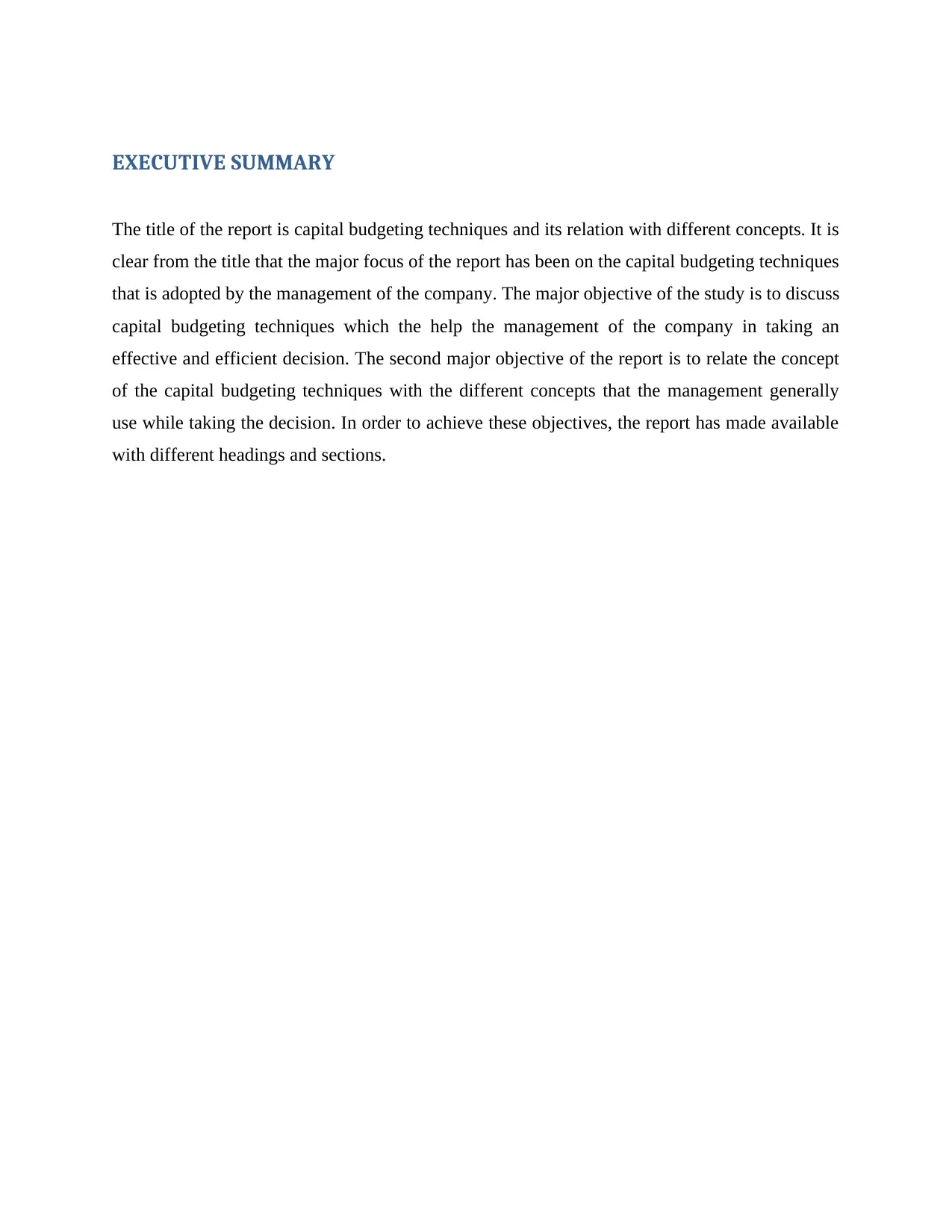
EXECUTIVE SUMMARY
The title of the report is capital budgeting techniques and its relation with different concepts. It is
clear from the title that the major focus of the report has been on the capital budgeting techniques
that is adopted by the management of the company. The major objective of the study is to discuss
capital budgeting techniques which the help the management of the company in taking an
effective and efficient decision. The second major objective of the report is to relate the concept
of the capital budgeting techniques with the different concepts that the management generally
use while taking the decision. In order to achieve these objectives, the report has made available
with different headings and sections.
The title of the report is capital budgeting techniques and its relation with different concepts. It is
clear from the title that the major focus of the report has been on the capital budgeting techniques
that is adopted by the management of the company. The major objective of the study is to discuss
capital budgeting techniques which the help the management of the company in taking an
effective and efficient decision. The second major objective of the report is to relate the concept
of the capital budgeting techniques with the different concepts that the management generally
use while taking the decision. In order to achieve these objectives, the report has made available
with different headings and sections.

Contents
EXECUTIVE SUMMARY.................................................................................................................................2
INTRODUCTION...........................................................................................................................................4
CAPITAL BUDGETING AND ITS RELATION....................................................................................................4
MEANING AND TYPE OF CAPITAL BUDGETING TECHNIQUES..................................................................5
RELATION WITH MANAGEMENT DECISION MAKING...............................................................................6
RELATION WITH DIFFERENT CONCEPTS...................................................................................................7
SENSITIVITY ANALYSIS.........................................................................................................................7
SCENARIO ANALYSIS............................................................................................................................7
BREAK EVEN ANALYSIS........................................................................................................................8
SIMULATION TECHNIQUES..................................................................................................................8
CONCLUSION AND RECOMMENDATION.....................................................................................................9
REFERENCES................................................................................................................................................9
EXECUTIVE SUMMARY.................................................................................................................................2
INTRODUCTION...........................................................................................................................................4
CAPITAL BUDGETING AND ITS RELATION....................................................................................................4
MEANING AND TYPE OF CAPITAL BUDGETING TECHNIQUES..................................................................5
RELATION WITH MANAGEMENT DECISION MAKING...............................................................................6
RELATION WITH DIFFERENT CONCEPTS...................................................................................................7
SENSITIVITY ANALYSIS.........................................................................................................................7
SCENARIO ANALYSIS............................................................................................................................7
BREAK EVEN ANALYSIS........................................................................................................................8
SIMULATION TECHNIQUES..................................................................................................................8
CONCLUSION AND RECOMMENDATION.....................................................................................................9
REFERENCES................................................................................................................................................9
⊘ This is a preview!⊘
Do you want full access?
Subscribe today to unlock all pages.

Trusted by 1+ million students worldwide
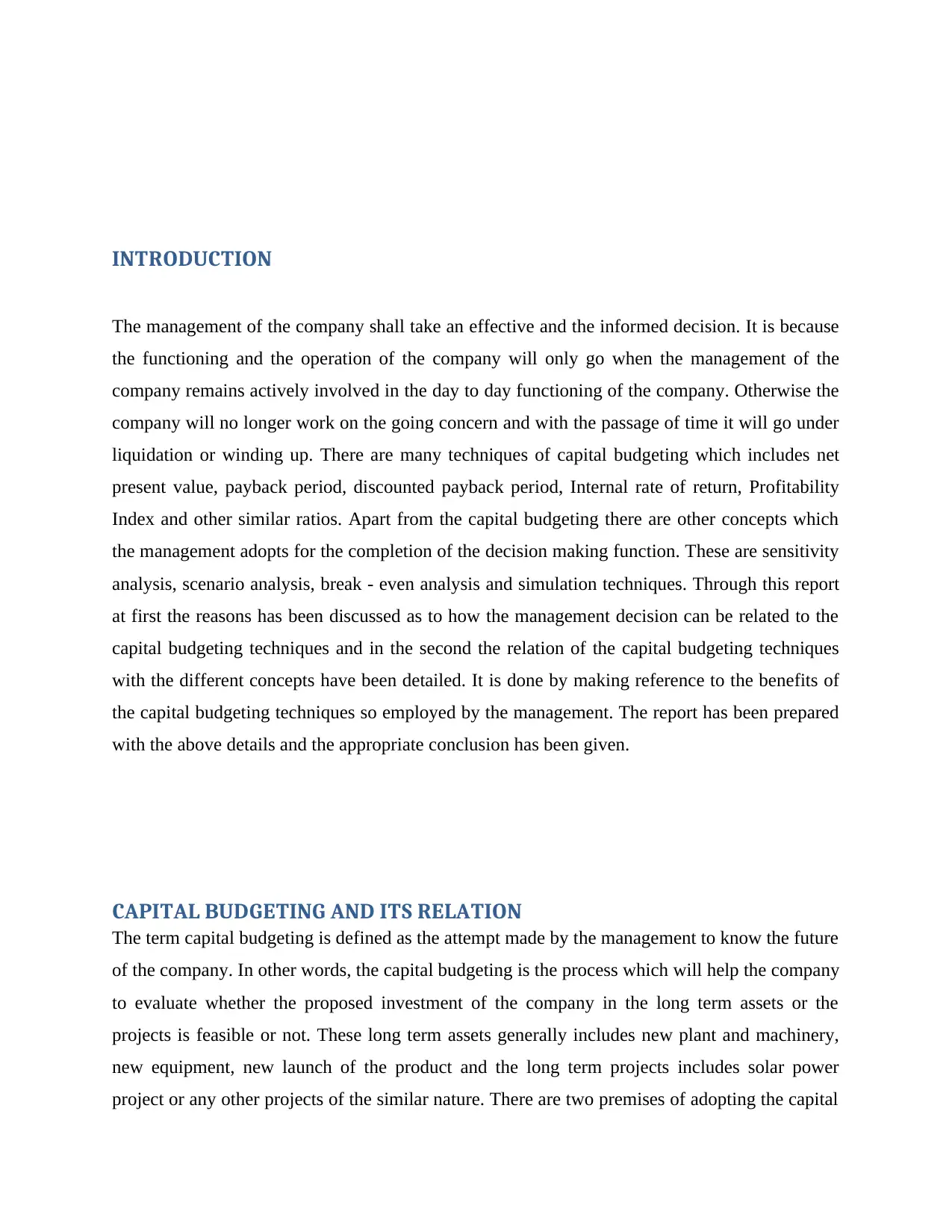
INTRODUCTION
The management of the company shall take an effective and the informed decision. It is because
the functioning and the operation of the company will only go when the management of the
company remains actively involved in the day to day functioning of the company. Otherwise the
company will no longer work on the going concern and with the passage of time it will go under
liquidation or winding up. There are many techniques of capital budgeting which includes net
present value, payback period, discounted payback period, Internal rate of return, Profitability
Index and other similar ratios. Apart from the capital budgeting there are other concepts which
the management adopts for the completion of the decision making function. These are sensitivity
analysis, scenario analysis, break - even analysis and simulation techniques. Through this report
at first the reasons has been discussed as to how the management decision can be related to the
capital budgeting techniques and in the second the relation of the capital budgeting techniques
with the different concepts have been detailed. It is done by making reference to the benefits of
the capital budgeting techniques so employed by the management. The report has been prepared
with the above details and the appropriate conclusion has been given.
CAPITAL BUDGETING AND ITS RELATION
The term capital budgeting is defined as the attempt made by the management to know the future
of the company. In other words, the capital budgeting is the process which will help the company
to evaluate whether the proposed investment of the company in the long term assets or the
projects is feasible or not. These long term assets generally includes new plant and machinery,
new equipment, new launch of the product and the long term projects includes solar power
project or any other projects of the similar nature. There are two premises of adopting the capital
The management of the company shall take an effective and the informed decision. It is because
the functioning and the operation of the company will only go when the management of the
company remains actively involved in the day to day functioning of the company. Otherwise the
company will no longer work on the going concern and with the passage of time it will go under
liquidation or winding up. There are many techniques of capital budgeting which includes net
present value, payback period, discounted payback period, Internal rate of return, Profitability
Index and other similar ratios. Apart from the capital budgeting there are other concepts which
the management adopts for the completion of the decision making function. These are sensitivity
analysis, scenario analysis, break - even analysis and simulation techniques. Through this report
at first the reasons has been discussed as to how the management decision can be related to the
capital budgeting techniques and in the second the relation of the capital budgeting techniques
with the different concepts have been detailed. It is done by making reference to the benefits of
the capital budgeting techniques so employed by the management. The report has been prepared
with the above details and the appropriate conclusion has been given.
CAPITAL BUDGETING AND ITS RELATION
The term capital budgeting is defined as the attempt made by the management to know the future
of the company. In other words, the capital budgeting is the process which will help the company
to evaluate whether the proposed investment of the company in the long term assets or the
projects is feasible or not. These long term assets generally includes new plant and machinery,
new equipment, new launch of the product and the long term projects includes solar power
project or any other projects of the similar nature. There are two premises of adopting the capital
Paraphrase This Document
Need a fresh take? Get an instant paraphrase of this document with our AI Paraphraser
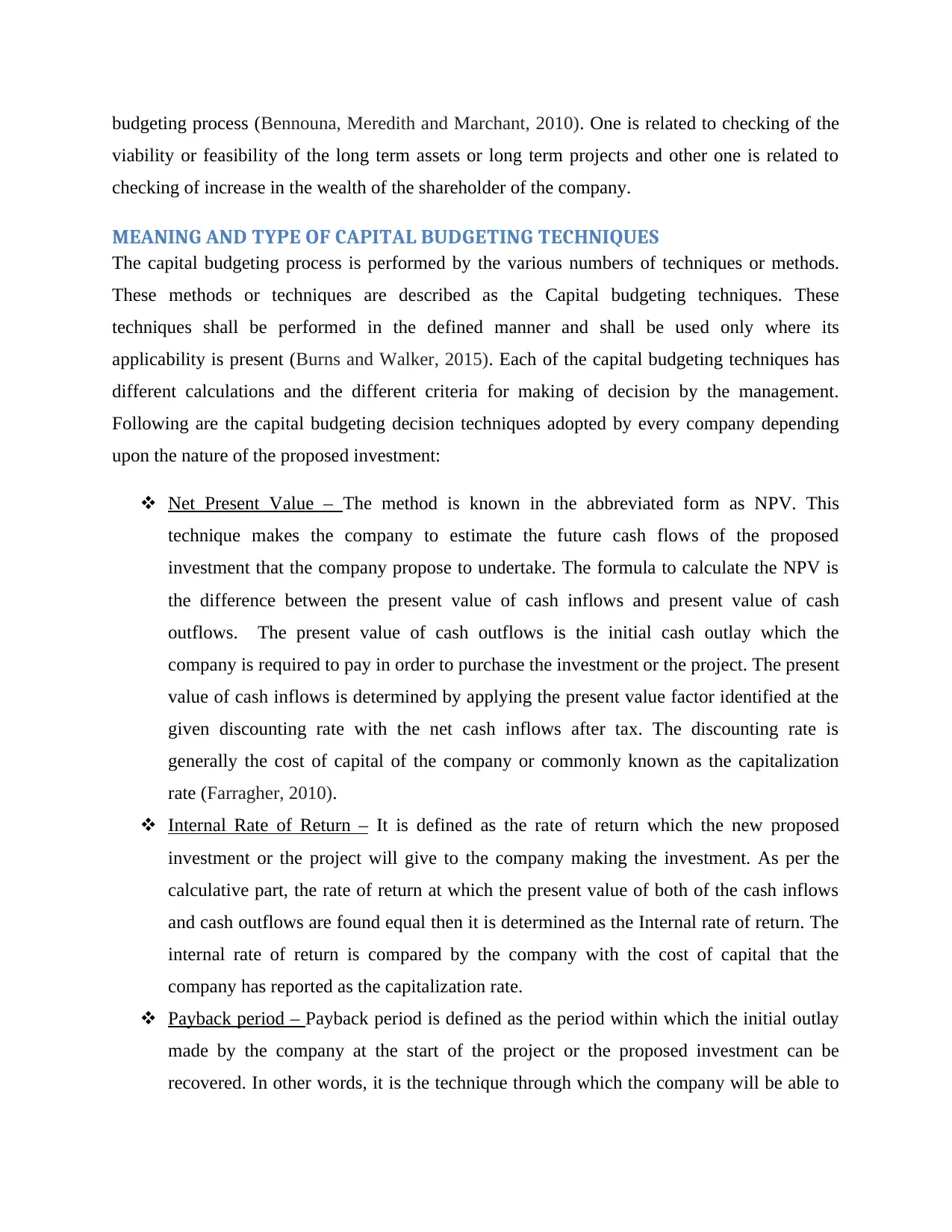
budgeting process (Bennouna, Meredith and Marchant, 2010). One is related to checking of the
viability or feasibility of the long term assets or long term projects and other one is related to
checking of increase in the wealth of the shareholder of the company.
MEANING AND TYPE OF CAPITAL BUDGETING TECHNIQUES
The capital budgeting process is performed by the various numbers of techniques or methods.
These methods or techniques are described as the Capital budgeting techniques. These
techniques shall be performed in the defined manner and shall be used only where its
applicability is present (Burns and Walker, 2015). Each of the capital budgeting techniques has
different calculations and the different criteria for making of decision by the management.
Following are the capital budgeting decision techniques adopted by every company depending
upon the nature of the proposed investment:
Net Present Value – The method is known in the abbreviated form as NPV. This
technique makes the company to estimate the future cash flows of the proposed
investment that the company propose to undertake. The formula to calculate the NPV is
the difference between the present value of cash inflows and present value of cash
outflows. The present value of cash outflows is the initial cash outlay which the
company is required to pay in order to purchase the investment or the project. The present
value of cash inflows is determined by applying the present value factor identified at the
given discounting rate with the net cash inflows after tax. The discounting rate is
generally the cost of capital of the company or commonly known as the capitalization
rate (Farragher, 2010).
Internal Rate of Return – It is defined as the rate of return which the new proposed
investment or the project will give to the company making the investment. As per the
calculative part, the rate of return at which the present value of both of the cash inflows
and cash outflows are found equal then it is determined as the Internal rate of return. The
internal rate of return is compared by the company with the cost of capital that the
company has reported as the capitalization rate.
Payback period – Payback period is defined as the period within which the initial outlay
made by the company at the start of the project or the proposed investment can be
recovered. In other words, it is the technique through which the company will be able to
viability or feasibility of the long term assets or long term projects and other one is related to
checking of increase in the wealth of the shareholder of the company.
MEANING AND TYPE OF CAPITAL BUDGETING TECHNIQUES
The capital budgeting process is performed by the various numbers of techniques or methods.
These methods or techniques are described as the Capital budgeting techniques. These
techniques shall be performed in the defined manner and shall be used only where its
applicability is present (Burns and Walker, 2015). Each of the capital budgeting techniques has
different calculations and the different criteria for making of decision by the management.
Following are the capital budgeting decision techniques adopted by every company depending
upon the nature of the proposed investment:
Net Present Value – The method is known in the abbreviated form as NPV. This
technique makes the company to estimate the future cash flows of the proposed
investment that the company propose to undertake. The formula to calculate the NPV is
the difference between the present value of cash inflows and present value of cash
outflows. The present value of cash outflows is the initial cash outlay which the
company is required to pay in order to purchase the investment or the project. The present
value of cash inflows is determined by applying the present value factor identified at the
given discounting rate with the net cash inflows after tax. The discounting rate is
generally the cost of capital of the company or commonly known as the capitalization
rate (Farragher, 2010).
Internal Rate of Return – It is defined as the rate of return which the new proposed
investment or the project will give to the company making the investment. As per the
calculative part, the rate of return at which the present value of both of the cash inflows
and cash outflows are found equal then it is determined as the Internal rate of return. The
internal rate of return is compared by the company with the cost of capital that the
company has reported as the capitalization rate.
Payback period – Payback period is defined as the period within which the initial outlay
made by the company at the start of the project or the proposed investment can be
recovered. In other words, it is the technique through which the company will be able to
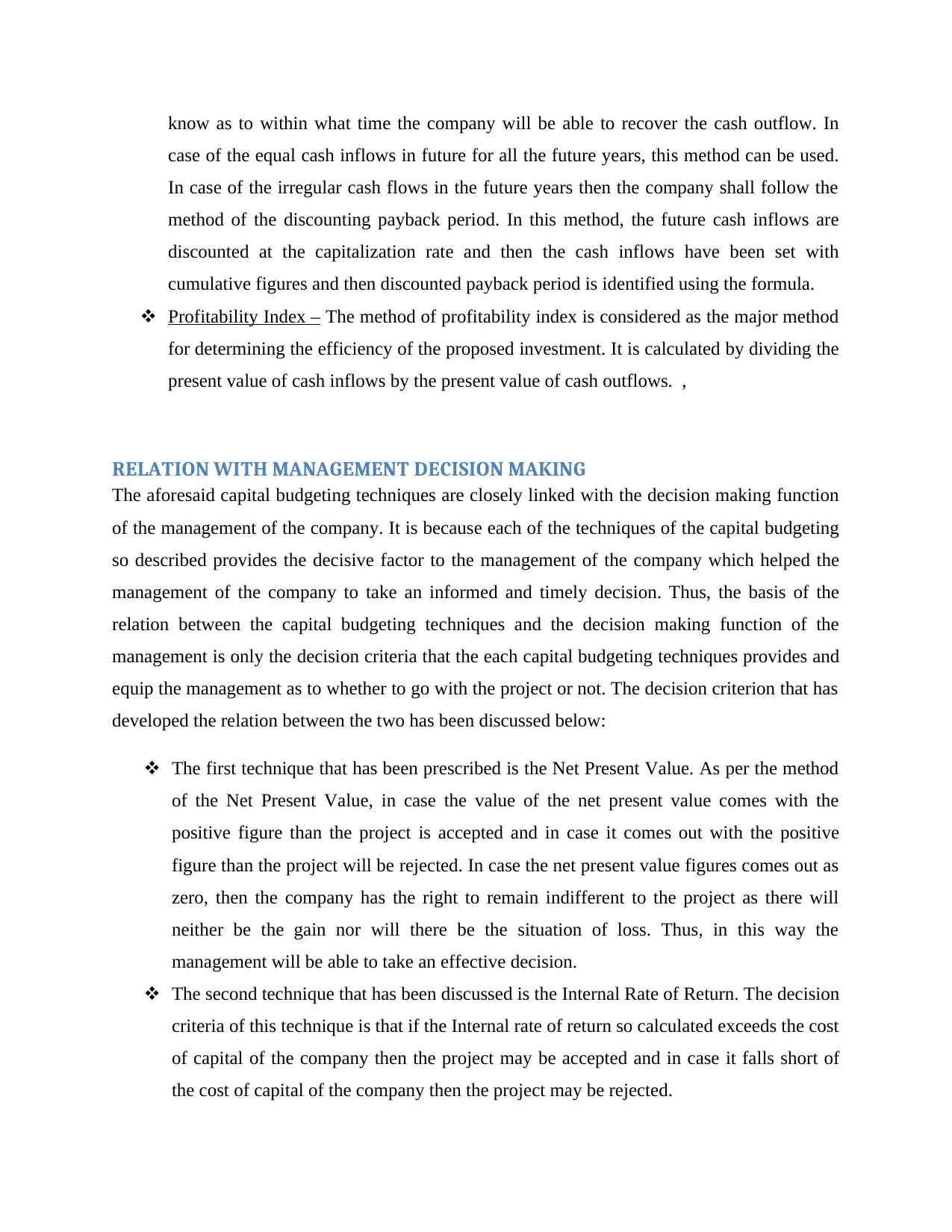
know as to within what time the company will be able to recover the cash outflow. In
case of the equal cash inflows in future for all the future years, this method can be used.
In case of the irregular cash flows in the future years then the company shall follow the
method of the discounting payback period. In this method, the future cash inflows are
discounted at the capitalization rate and then the cash inflows have been set with
cumulative figures and then discounted payback period is identified using the formula.
Profitability Index – The method of profitability index is considered as the major method
for determining the efficiency of the proposed investment. It is calculated by dividing the
present value of cash inflows by the present value of cash outflows. ,
RELATION WITH MANAGEMENT DECISION MAKING
The aforesaid capital budgeting techniques are closely linked with the decision making function
of the management of the company. It is because each of the techniques of the capital budgeting
so described provides the decisive factor to the management of the company which helped the
management of the company to take an informed and timely decision. Thus, the basis of the
relation between the capital budgeting techniques and the decision making function of the
management is only the decision criteria that the each capital budgeting techniques provides and
equip the management as to whether to go with the project or not. The decision criterion that has
developed the relation between the two has been discussed below:
The first technique that has been prescribed is the Net Present Value. As per the method
of the Net Present Value, in case the value of the net present value comes with the
positive figure than the project is accepted and in case it comes out with the positive
figure than the project will be rejected. In case the net present value figures comes out as
zero, then the company has the right to remain indifferent to the project as there will
neither be the gain nor will there be the situation of loss. Thus, in this way the
management will be able to take an effective decision.
The second technique that has been discussed is the Internal Rate of Return. The decision
criteria of this technique is that if the Internal rate of return so calculated exceeds the cost
of capital of the company then the project may be accepted and in case it falls short of
the cost of capital of the company then the project may be rejected.
case of the equal cash inflows in future for all the future years, this method can be used.
In case of the irregular cash flows in the future years then the company shall follow the
method of the discounting payback period. In this method, the future cash inflows are
discounted at the capitalization rate and then the cash inflows have been set with
cumulative figures and then discounted payback period is identified using the formula.
Profitability Index – The method of profitability index is considered as the major method
for determining the efficiency of the proposed investment. It is calculated by dividing the
present value of cash inflows by the present value of cash outflows. ,
RELATION WITH MANAGEMENT DECISION MAKING
The aforesaid capital budgeting techniques are closely linked with the decision making function
of the management of the company. It is because each of the techniques of the capital budgeting
so described provides the decisive factor to the management of the company which helped the
management of the company to take an informed and timely decision. Thus, the basis of the
relation between the capital budgeting techniques and the decision making function of the
management is only the decision criteria that the each capital budgeting techniques provides and
equip the management as to whether to go with the project or not. The decision criterion that has
developed the relation between the two has been discussed below:
The first technique that has been prescribed is the Net Present Value. As per the method
of the Net Present Value, in case the value of the net present value comes with the
positive figure than the project is accepted and in case it comes out with the positive
figure than the project will be rejected. In case the net present value figures comes out as
zero, then the company has the right to remain indifferent to the project as there will
neither be the gain nor will there be the situation of loss. Thus, in this way the
management will be able to take an effective decision.
The second technique that has been discussed is the Internal Rate of Return. The decision
criteria of this technique is that if the Internal rate of return so calculated exceeds the cost
of capital of the company then the project may be accepted and in case it falls short of
the cost of capital of the company then the project may be rejected.
⊘ This is a preview!⊘
Do you want full access?
Subscribe today to unlock all pages.

Trusted by 1+ million students worldwide
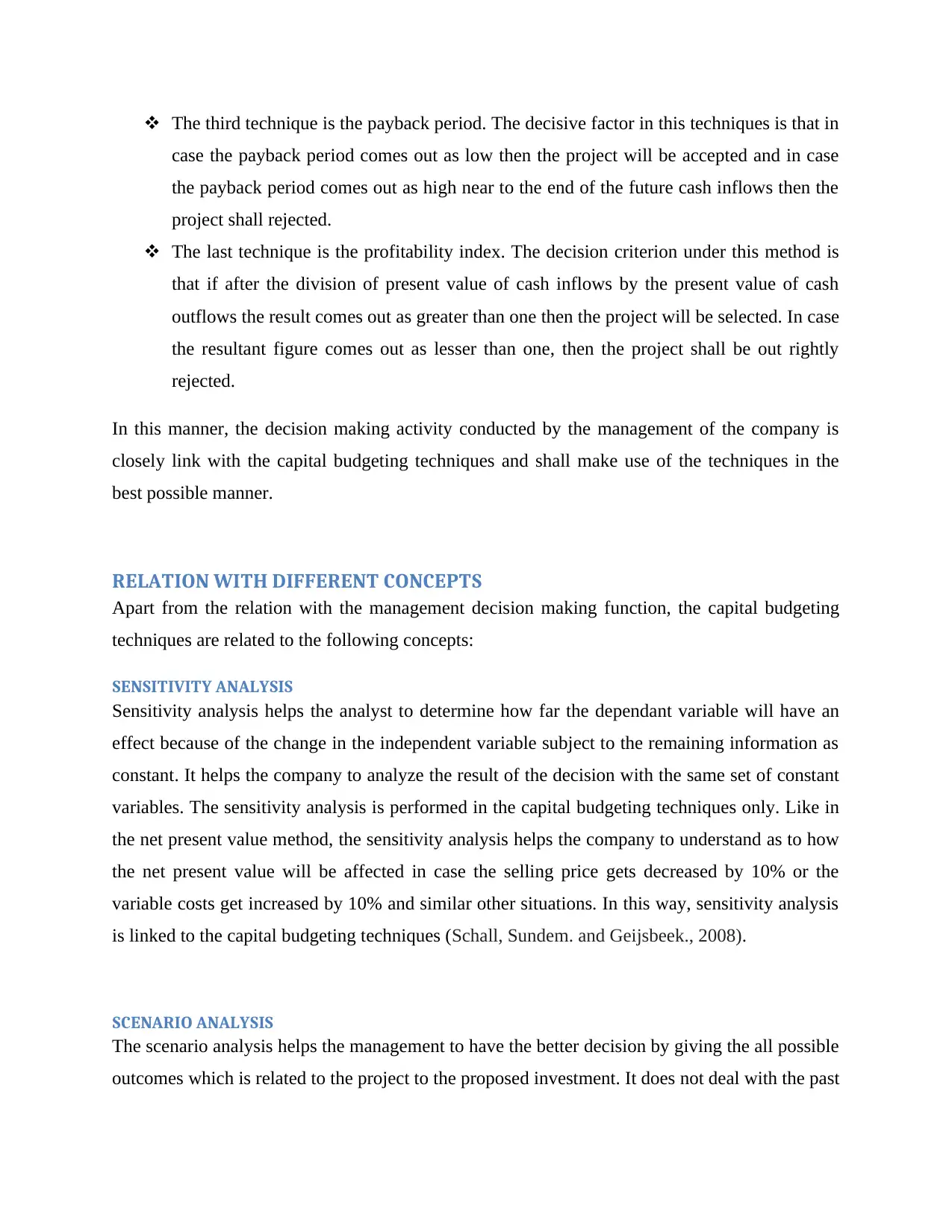
The third technique is the payback period. The decisive factor in this techniques is that in
case the payback period comes out as low then the project will be accepted and in case
the payback period comes out as high near to the end of the future cash inflows then the
project shall rejected.
The last technique is the profitability index. The decision criterion under this method is
that if after the division of present value of cash inflows by the present value of cash
outflows the result comes out as greater than one then the project will be selected. In case
the resultant figure comes out as lesser than one, then the project shall be out rightly
rejected.
In this manner, the decision making activity conducted by the management of the company is
closely link with the capital budgeting techniques and shall make use of the techniques in the
best possible manner.
RELATION WITH DIFFERENT CONCEPTS
Apart from the relation with the management decision making function, the capital budgeting
techniques are related to the following concepts:
SENSITIVITY ANALYSIS
Sensitivity analysis helps the analyst to determine how far the dependant variable will have an
effect because of the change in the independent variable subject to the remaining information as
constant. It helps the company to analyze the result of the decision with the same set of constant
variables. The sensitivity analysis is performed in the capital budgeting techniques only. Like in
the net present value method, the sensitivity analysis helps the company to understand as to how
the net present value will be affected in case the selling price gets decreased by 10% or the
variable costs get increased by 10% and similar other situations. In this way, sensitivity analysis
is linked to the capital budgeting techniques (Schall, Sundem. and Geijsbeek., 2008).
SCENARIO ANALYSIS
The scenario analysis helps the management to have the better decision by giving the all possible
outcomes which is related to the project to the proposed investment. It does not deal with the past
case the payback period comes out as low then the project will be accepted and in case
the payback period comes out as high near to the end of the future cash inflows then the
project shall rejected.
The last technique is the profitability index. The decision criterion under this method is
that if after the division of present value of cash inflows by the present value of cash
outflows the result comes out as greater than one then the project will be selected. In case
the resultant figure comes out as lesser than one, then the project shall be out rightly
rejected.
In this manner, the decision making activity conducted by the management of the company is
closely link with the capital budgeting techniques and shall make use of the techniques in the
best possible manner.
RELATION WITH DIFFERENT CONCEPTS
Apart from the relation with the management decision making function, the capital budgeting
techniques are related to the following concepts:
SENSITIVITY ANALYSIS
Sensitivity analysis helps the analyst to determine how far the dependant variable will have an
effect because of the change in the independent variable subject to the remaining information as
constant. It helps the company to analyze the result of the decision with the same set of constant
variables. The sensitivity analysis is performed in the capital budgeting techniques only. Like in
the net present value method, the sensitivity analysis helps the company to understand as to how
the net present value will be affected in case the selling price gets decreased by 10% or the
variable costs get increased by 10% and similar other situations. In this way, sensitivity analysis
is linked to the capital budgeting techniques (Schall, Sundem. and Geijsbeek., 2008).
SCENARIO ANALYSIS
The scenario analysis helps the management to have the better decision by giving the all possible
outcomes which is related to the project to the proposed investment. It does not deal with the past
Paraphrase This Document
Need a fresh take? Get an instant paraphrase of this document with our AI Paraphraser
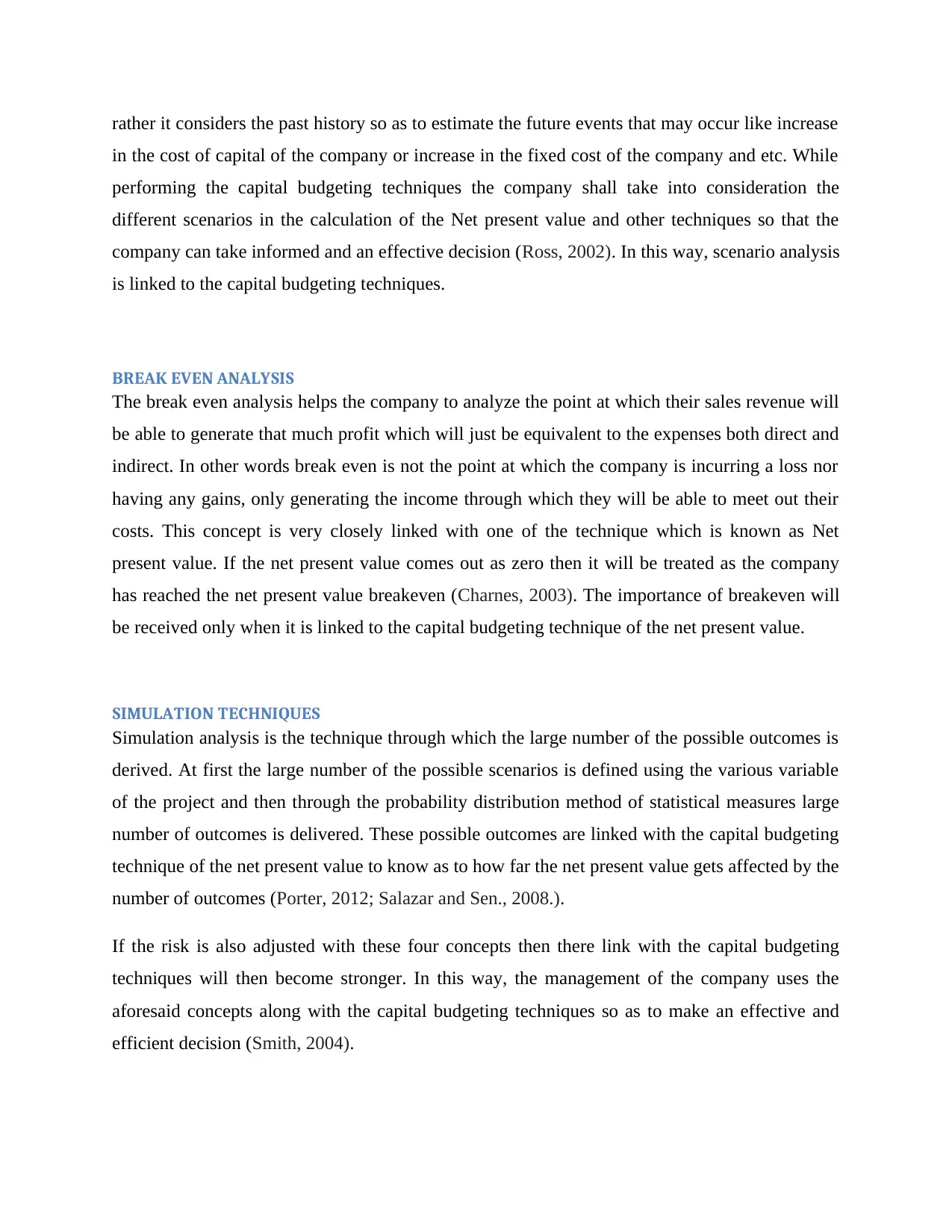
rather it considers the past history so as to estimate the future events that may occur like increase
in the cost of capital of the company or increase in the fixed cost of the company and etc. While
performing the capital budgeting techniques the company shall take into consideration the
different scenarios in the calculation of the Net present value and other techniques so that the
company can take informed and an effective decision (Ross, 2002). In this way, scenario analysis
is linked to the capital budgeting techniques.
BREAK EVEN ANALYSIS
The break even analysis helps the company to analyze the point at which their sales revenue will
be able to generate that much profit which will just be equivalent to the expenses both direct and
indirect. In other words break even is not the point at which the company is incurring a loss nor
having any gains, only generating the income through which they will be able to meet out their
costs. This concept is very closely linked with one of the technique which is known as Net
present value. If the net present value comes out as zero then it will be treated as the company
has reached the net present value breakeven (Charnes, 2003). The importance of breakeven will
be received only when it is linked to the capital budgeting technique of the net present value.
SIMULATION TECHNIQUES
Simulation analysis is the technique through which the large number of the possible outcomes is
derived. At first the large number of the possible scenarios is defined using the various variable
of the project and then through the probability distribution method of statistical measures large
number of outcomes is delivered. These possible outcomes are linked with the capital budgeting
technique of the net present value to know as to how far the net present value gets affected by the
number of outcomes (Porter, 2012; Salazar and Sen., 2008.).
If the risk is also adjusted with these four concepts then there link with the capital budgeting
techniques will then become stronger. In this way, the management of the company uses the
aforesaid concepts along with the capital budgeting techniques so as to make an effective and
efficient decision (Smith, 2004).
in the cost of capital of the company or increase in the fixed cost of the company and etc. While
performing the capital budgeting techniques the company shall take into consideration the
different scenarios in the calculation of the Net present value and other techniques so that the
company can take informed and an effective decision (Ross, 2002). In this way, scenario analysis
is linked to the capital budgeting techniques.
BREAK EVEN ANALYSIS
The break even analysis helps the company to analyze the point at which their sales revenue will
be able to generate that much profit which will just be equivalent to the expenses both direct and
indirect. In other words break even is not the point at which the company is incurring a loss nor
having any gains, only generating the income through which they will be able to meet out their
costs. This concept is very closely linked with one of the technique which is known as Net
present value. If the net present value comes out as zero then it will be treated as the company
has reached the net present value breakeven (Charnes, 2003). The importance of breakeven will
be received only when it is linked to the capital budgeting technique of the net present value.
SIMULATION TECHNIQUES
Simulation analysis is the technique through which the large number of the possible outcomes is
derived. At first the large number of the possible scenarios is defined using the various variable
of the project and then through the probability distribution method of statistical measures large
number of outcomes is delivered. These possible outcomes are linked with the capital budgeting
technique of the net present value to know as to how far the net present value gets affected by the
number of outcomes (Porter, 2012; Salazar and Sen., 2008.).
If the risk is also adjusted with these four concepts then there link with the capital budgeting
techniques will then become stronger. In this way, the management of the company uses the
aforesaid concepts along with the capital budgeting techniques so as to make an effective and
efficient decision (Smith, 2004).
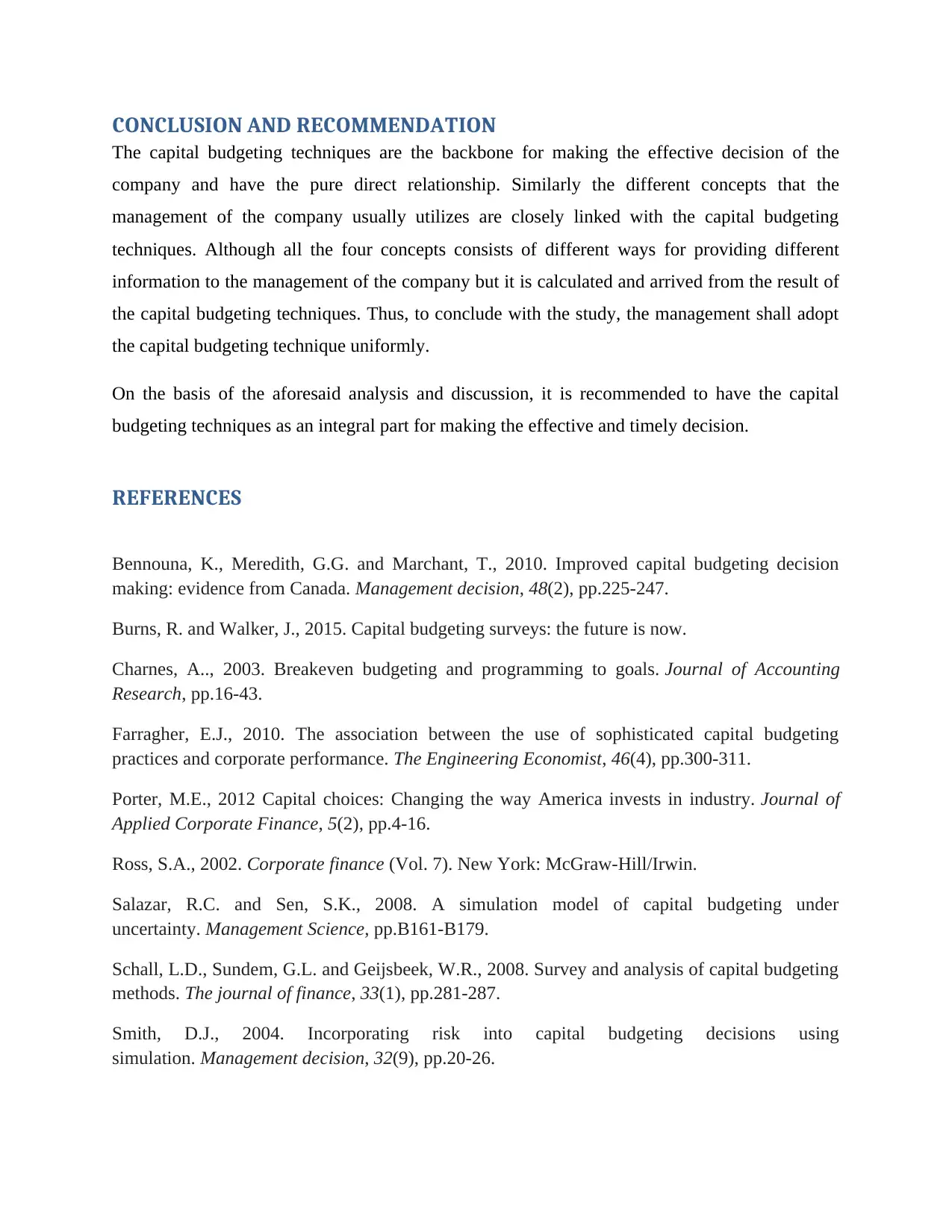
CONCLUSION AND RECOMMENDATION
The capital budgeting techniques are the backbone for making the effective decision of the
company and have the pure direct relationship. Similarly the different concepts that the
management of the company usually utilizes are closely linked with the capital budgeting
techniques. Although all the four concepts consists of different ways for providing different
information to the management of the company but it is calculated and arrived from the result of
the capital budgeting techniques. Thus, to conclude with the study, the management shall adopt
the capital budgeting technique uniformly.
On the basis of the aforesaid analysis and discussion, it is recommended to have the capital
budgeting techniques as an integral part for making the effective and timely decision.
REFERENCES
Bennouna, K., Meredith, G.G. and Marchant, T., 2010. Improved capital budgeting decision
making: evidence from Canada. Management decision, 48(2), pp.225-247.
Burns, R. and Walker, J., 2015. Capital budgeting surveys: the future is now.
Charnes, A.., 2003. Breakeven budgeting and programming to goals. Journal of Accounting
Research, pp.16-43.
Farragher, E.J., 2010. The association between the use of sophisticated capital budgeting
practices and corporate performance. The Engineering Economist, 46(4), pp.300-311.
Porter, M.E., 2012 Capital choices: Changing the way America invests in industry. Journal of
Applied Corporate Finance, 5(2), pp.4-16.
Ross, S.A., 2002. Corporate finance (Vol. 7). New York: McGraw-Hill/Irwin.
Salazar, R.C. and Sen, S.K., 2008. A simulation model of capital budgeting under
uncertainty. Management Science, pp.B161-B179.
Schall, L.D., Sundem, G.L. and Geijsbeek, W.R., 2008. Survey and analysis of capital budgeting
methods. The journal of finance, 33(1), pp.281-287.
Smith, D.J., 2004. Incorporating risk into capital budgeting decisions using
simulation. Management decision, 32(9), pp.20-26.
The capital budgeting techniques are the backbone for making the effective decision of the
company and have the pure direct relationship. Similarly the different concepts that the
management of the company usually utilizes are closely linked with the capital budgeting
techniques. Although all the four concepts consists of different ways for providing different
information to the management of the company but it is calculated and arrived from the result of
the capital budgeting techniques. Thus, to conclude with the study, the management shall adopt
the capital budgeting technique uniformly.
On the basis of the aforesaid analysis and discussion, it is recommended to have the capital
budgeting techniques as an integral part for making the effective and timely decision.
REFERENCES
Bennouna, K., Meredith, G.G. and Marchant, T., 2010. Improved capital budgeting decision
making: evidence from Canada. Management decision, 48(2), pp.225-247.
Burns, R. and Walker, J., 2015. Capital budgeting surveys: the future is now.
Charnes, A.., 2003. Breakeven budgeting and programming to goals. Journal of Accounting
Research, pp.16-43.
Farragher, E.J., 2010. The association between the use of sophisticated capital budgeting
practices and corporate performance. The Engineering Economist, 46(4), pp.300-311.
Porter, M.E., 2012 Capital choices: Changing the way America invests in industry. Journal of
Applied Corporate Finance, 5(2), pp.4-16.
Ross, S.A., 2002. Corporate finance (Vol. 7). New York: McGraw-Hill/Irwin.
Salazar, R.C. and Sen, S.K., 2008. A simulation model of capital budgeting under
uncertainty. Management Science, pp.B161-B179.
Schall, L.D., Sundem, G.L. and Geijsbeek, W.R., 2008. Survey and analysis of capital budgeting
methods. The journal of finance, 33(1), pp.281-287.
Smith, D.J., 2004. Incorporating risk into capital budgeting decisions using
simulation. Management decision, 32(9), pp.20-26.
⊘ This is a preview!⊘
Do you want full access?
Subscribe today to unlock all pages.

Trusted by 1+ million students worldwide
1 out of 9
Related Documents
Your All-in-One AI-Powered Toolkit for Academic Success.
+13062052269
info@desklib.com
Available 24*7 on WhatsApp / Email
![[object Object]](/_next/static/media/star-bottom.7253800d.svg)
Unlock your academic potential
© 2024 | Zucol Services PVT LTD | All rights reserved.





